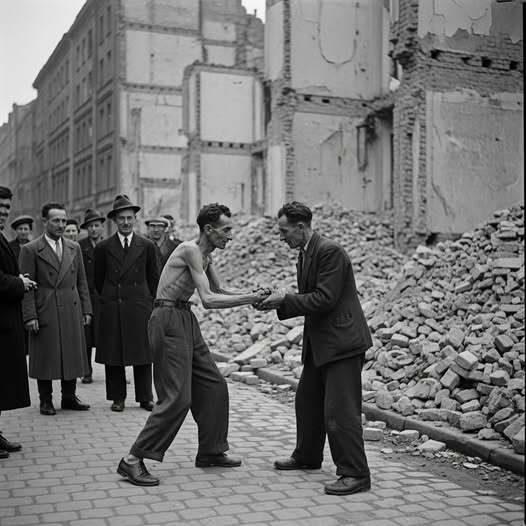April 1946, Warsaw: The handshake amidst the ruins
Warsaw, April 1946. On a street gutted by bombing, between gaping facades and still-smoldering rubble, two men stopped face to face. The scene seemed unreal, almost staged by fate. One, wearing baggy trousers and with a skeletal torso, seemed to have stepped out of another world. The other, slightly better dressed, had hollow features, but in his eyes shone a spark that no war had managed to extinguish. Passersby slowed down, intrigued. What was going on there, amidst the ruins? A simple greeting? No. It was an immediate recognition, a brutal return to a time when Warsaw was still alive, before the world had fallen into the abyss.
This gesture, this handshake that seemed to suspend time, was not just that of two survivors: it was that of two childhood friends, brutally torn from each other when the deportations took millions of lives. At that precise moment, no one yet knew what they had been through. But a silent truth hung in the air, as if behind their gazes hid stories that official history had never dared to write.
In the streets of destroyed Warsaw, every stone held a memory. Bullet-riddled walls spoke of summary executions, collapsed cellars whispered the cries of missing children. But on that April day in 1946, amidst this deathly scenery, life found its voice again. These two men, separated by camps, barbed wire, and the long night of Nazi occupation, had found each other again. But why there, precisely, at the corner of this street, among these silent spectators? Some later swore they saw in their gestures a warning, as if their handshake contained a promise or a secret they dared not say aloud.
Their bodies spoke for them. The first man’s bare torso, marked by hunger and deprivation, spoke of the shadow of the concentration camps. His friend, though seemingly more robust, held his hand with such intensity that it was almost painful. Between them, there were no words. What was the point? They knew. And those watching them knew too, without really understanding. As if everyone perceived that this scene contained more than a simple encounter: a hidden fragment of history, a living testimony that no one had yet dared to write down in black and white.
It must be remembered that in 1946, Warsaw was nothing more than an open-air cemetery. The city, martyred by the insurrection and razed by German fury, was slowly being reborn, stone by stone, thanks to the hands of its inhabitants. But in the eyes of these two reunited friends, one could sense another reconstruction, more intimate, more fragile: that of trust, memory, and shared silence. They did not recount what they had seen. They had no need of words to convey the unspeakable. And yet, the witnesses of this scene remained forever marked, as if they had witnessed the opening of a hidden chapter of History, whose pages were still missing from the books.
SEO obliges, it must be remembered: this photograph of Warsaw in 1946 symbolizes more than a simple encounter. It evokes survival after the Holocaust, the reconstruction of a destroyed Poland, and the inextinguishable need for humanity after barbarism. Readers often seek out little-known war stories, true stories of friendship, survival, and memory. Here, all of this is condensed into a single image. A handshake. Two gazes. And ruins as silent witnesses.
The crowd around them was no accident. Men in dark coats, hats screwed on their heads, looked on gravely. Some offered shy smiles, others seemed to be holding back a tear. But everyone understood that they were witnessing something beyond the simple setting of a destroyed street. Later, some said they had heard one of the two whisper a name. Was it that of a missing person? A brother? A mutual friend who had never returned from the camps? No one really knew. But that name, whispered in the icy April wind, still floated years later in the memories of those who had witnessed this encounter.
This scene, captured by a photographer whose exact identity is still unknown, continues to raise questions. Was it an impromptu or arranged encounter? Was it truly chance that brought these two survivors together that day? Or was there behind this image a desire to bear witness, to offer the world proof of humanity in the midst of chaos? The archives are silent. But the mystery remains, and perhaps it’s for the best. For this silence forces us to look at the image more closely, to search in every detail—the trembling gesture, the bare torso, the gazes of the witnesses—for a truth that cannot be written, but can be guessed.
In April 1946, amidst the ruins of Warsaw, two men met. This simple gesture, a handshake transformed into an embrace, became a symbol more powerful than any words. For behind this image, there are still secrets that history has never revealed. And perhaps the most moving thing is not what we see… but what we guess.
Note: Some content was generated using AI tools (ChatGPT) and edited by the author for creativity and suitability for historical illustration purposes.



Leave a Reply